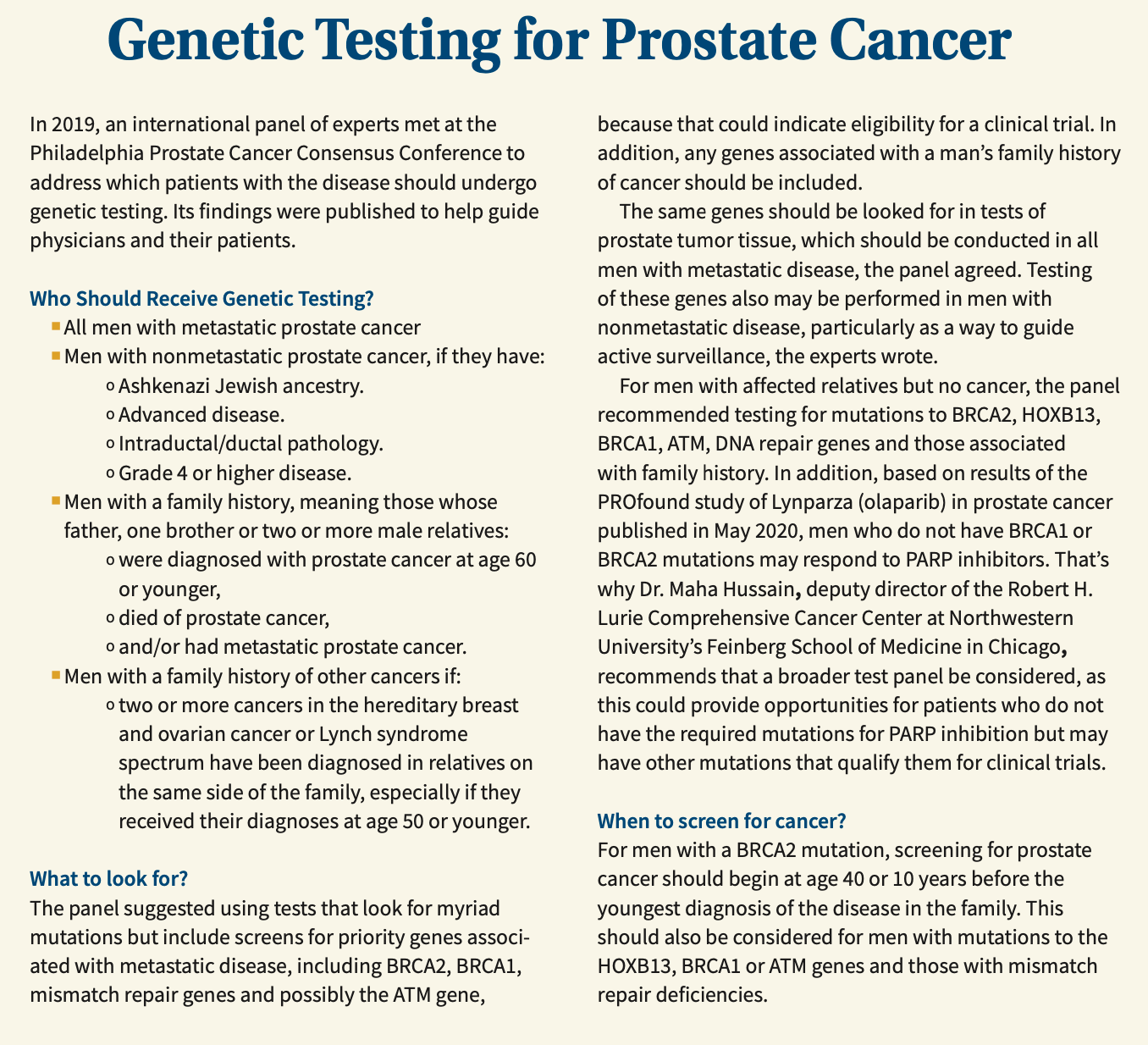Publication
Article
CURE
PARP Inhibitors Demonstrate the Value of Targeted Treatments in Prostate Cancer
Author(s):
Primed to knock out cells vulnerable due to DNA-repair problems, PARP inhibitors are ushering in a targeted-drug era in prostate cancer treatment.
Darryl Elzy, 60, an Air Force retiree from North Carolina, has been living with prostate cancer for about 12 years and has been a participant in clinical trials almost as long.
“Every time they offered me a trial, I said, ‘Sign me up!’” Elzy says.
Earlier this year, Elzy completed a clinical trial — his third — testing PARP inhibitors, a class of drugs that is new to the treatment of prostate cancer. PARP is an enzyme in cells that helps repair DNA when it becomes damaged. The inhibitors can block PARP in cancer cells, keeping them from repairing their damaged DNA and causing them to die.
PARP inhibitors were first approved by the United States Food and Drug Administration (FDA) in 2014 to treat certain ovarian cancers and, more recently, to treat breast cancers. In May, two PARP inhibitors became the first in their class approved as therapies for certain metastatic prostate cancers, ushering in a new era of treatment with targeted drugs.
While drugs that suppress the hormones that fuel metastatic prostate cancer are the mainstay of treatment, PARP inhibitors can help certain patients whose disease has become resistant to those medications.
In particular, the patients most likely to benefit from PARP inhibitors are those who have tumors with DNA repair defects. It is for those patients that Lynparza (olaparib) and Rubraca (rucaparib) are intended.
“Our bodies have mechanisms in place to repair damage that happens to our DNA,” explains Dr. Veda N. Giri, director of cancer risk assessment and clinical cancer genetics at the Sidney Kimmel Cancer Center at Thomas Jefferson University in Philadelphia. DNA damage happens on a daily basis and can be caused by things such as exposure to ultraviolet light, radiation, cell turnover or substances in the environment.
“DNA houses genes that act as the control center for our cells and tell the cells what to do,” Giri says. “If DNA is damaged in the region that houses those genes — called DNA repair deficiency — it can lead to improper signals and result in disease conditions such as cancer.”
One-Two Punch
Mutations in DNA repair genes can be acquired, meaning that the mutation develops in the tumor as it grows, or they can be inherited, meaning that the glitches are present throughout the body in all of a patient’s cells.
“Reports state that about 25% to 30% of men with metastatic prostate cancer have acquired, tumor-only DNA repair deficiency mutations, and about 12% to 17% of men have inherited mutations,” Giri says. “For men with earlier-stage prostate cancer, about 5% to 7% have inherited mutations.”
"I always say 'I have cancer but cancer doesn't have me.' I can't let it consume me." -Darryl Elzy, patient with prostate cancer

Among the most common DNA repair deficiency mutations are BRCA1 and BRCA2 gene mutations and a mutation in ATM, a “BRCA-like” gene also involved in DNA repair, Giri says.
DNA repair deficiencies affect signaling pathways, strings of chemical reactions that pass messages to a cell from its environment about how to behave. Pathways are associated with proteins encoded by specific genes.
When cancer cells have a DNA repair deficiency in the BRCA pathway, for example, the cells adapt and use an alternative pathway to repair themselves. PARP is one of those pathways. Using PARP inhibitors in patients who have an existing DNA repair deficiency delivers a one-two punch (known in scientific terms as “synthetic lethality”) to the cancer cells, which leads to cell death.
New To Prostate Cancer
The exact percentage of men with DNA repair mutations who will benefit from these drugs is still being established, according to Dr. Joshua M. Lang, associate professor of hematology, medical oncology and palliative care at the University of Wisconsin School of Medicine and Public Health in Madison. That is because, for many years, it was thought that genetics were not as important in prostate cancer as in other cancers.
“Fundamentally, this is all a new area in prostate cancer,” Lang says. “In the last five years, we have become aware of genetic changes associated with prostate cancer not just in the tumor cells, but also in genes that can be inherited.”
Previously, the majority of genomic testing was done in samples taken during prostatectomy, meaning the surgical removal of the prostate, Lang explains. While inherited mutations can be found through tests of blood, saliva or tissue samples, experts are learning that acquired mutations — the ones that occur in the cancer as it grows — are not always present in the prostatectomy sample and may only appear later in biopsies taken from metastatic sites.
Elzy received a diagnosis of prostate cancer when he was 48. Although the average age at diagnosis is about 66, men found to have an inherited BRCA2 mutation are more than four times as likely than those without the mutation to receive a diagnosis before that age. Compared with men who don’t have the mutation, the risk of prostate cancer is more than eightfold higher for men who have the BRCA2 mutation and are 65 or older.
Elzy was initially treated with radiation and a prostatectomy to remove the tumor.
“My doctor realized that a portion of my cancer was outside of the margin of being able to remove it, so I knew that there was still the possibility of lingering tumor that we couldn’t reach,” Elzy says.

To address the lingering cancer cells, Elzy underwent chemotherapy, but his blood level of the protein prostate-specific antigen (PSA) — which often rises in response to the growth of prostate cancer — continued to increase. That is when his physician began to look for clinical trials.
“My first two trials both had good results to start, but all of a sudden the PSA would start rising again,” Elzy says.
Eventually, his doctor decided that Elzy should be sent for genetic testing. The National Comprehensive Cancer Center now recommends that all men with metastatic prostate cancer undergo blood tests to determine if they have inherited DNA repair deficiency. Testing can also be done on tumor samples to look for acquired mutations.
Elzy’s results revealed a BRCA2 mutation that his doctors suspect he inherited from his mother, who died of breast cancer in 1992. If genetic testing had been more advanced back then, Elzy, who has no siblings or children, likely would have been advised to undergo genetic testing to find out if he had inherited the mutation.
Dr. Maha Hussain, deputy director of the Robert H. Lurie Comprehensive Cancer Center at Northwestern University’s Feinberg School of Medicine in Chicago, noted that, at the moment, having information about inherited mutations does not change the initial approach to treating newly diagnosed prostate cancer. Similarly, knowing a patient is BRCA-negative when newly diagnosed does not eliminate the possibility that the tumor will acquire a mutation as it grows.
“This could all change as our knowledge improves,” Hussain says. However, in her practice, Hussain says she has begun to send tissue for testing in men with high-risk, hormone-sensitive disease or prostate cancer that has recently stopped responding to hormone-suppressing drugs. “Getting prepared and ahead of the game is the best approach,” she says. “Clearly, testing for germline has implications for blood relatives, and I offer patients the opportunity.”
In Elzy’s case, once he learned that he had an inherited mutation, he was quickly recruited into a clinical trial of a PARP inhibitor.
Available Treatments
Lynparza and Rubraca are the only PARP inhibitors approved by the FDA so far for men with metastatic castration-resistant prostate cancer (mCRPC), meaning disease that has spread beyond the prostate and has progressed on hormone-suppressing treatments. Lynparza is approved to treat men with cancer that progressed after treatment with one of two hormone-based prostate cancer therapies, Xtandi (enzalutamide) or Zytiga (abiraterone).
To be eligible, patients must have a mutation in one of the homologous recombination repair (HRR) genes, specifically BRCA1, BRCA2 or ATM, which constitutes a DNA repair deficiency. Patients can be selected as good candidates to receive the therapy based on the results of an FDA-approved companion diagnostic for Lynparza.
Rubraca is approved for men with mCRPC and a BRCA1 or BRCA2 mutation who have received treatment with androgen receptor-directed therapy and a taxane-based chemotherapy.
Lynparza was approved based on the results of a clinical trial comparing the drug against Xtandi or Zytiga. Men with BRCA1, BRCA2 or ATM mutations were assigned to treatment with Lynparza, while men with any of 12 other mutations associated with HRR were given Xtandi or Zytiga. Men treated with the PARP inhibitor went twice as long before experiencing disease progression (7.4 months versus 3.6 months), and early data showed that their overall survival was nearly five months longer than those in the group that received hormonal treatment (19.1 months versus 14.7 months).
Patrick McGuire stands at Denali National Park in Alaska about 10 years ago, before he was treated for cancer.

In patients who had tumors that could be measured, about one-third of those who received Lynparza saw their tumor respond to the drug compared with only 2% of men treated with the other drugs. When looking at all the men in the study, including those with mutations other than BRCA or ATM, a meaningful delay in disease progression was observed among those who took Lynparza compared with investigator’s choice of treatment (5.8 months versus
3.5 months).
Response to Lynparza also may vary depending on the type of mutation, with the phase 2 TOPARP-B study showing that 80% of patients with a BRCA1 or BRCA2 mutation responded to the treatment while 37% of patients with ATM mutations responded.
Rubraca was approved based on the results of a trial in which all patients received the PARP inhibitor and a hormone-suppressing drug. In this study, 42% of the men who participated saw their tumor respond to the drug. “There are many ways to assess response, including the rate of PSA decline, the shrinkage of tumors and delaying cancer progression,” Hussain said.
“Based on the PROfound trial, the odds of response to Lynparza as measured by PSA decline of 50% or greater was seen in 43% who had BRCA1, 2 or ATM mutations compared with 8% (six of 77) in the patients who received Zytiga/prednisone or Xtandi. In the overall study population, a PSA response was confirmed in 30% in the Lynparza group compared with 10% in the control group. The data also show benefit in terms of significantly delaying pain progression, which is a critical point from a quality-of-life perspective.”
Tumor Response
Patrick McGuire, 73, a retired scientist from Wisconsin, has benefited from PARP inhibitors. McGuire received a diagnosis of prostate cancer in October 2015. After under-going prostatectomy, he learned he had metastatic disease and began to participate in clinical trials. Like Elzy, he found that each trial led to only a temporary improvement in his disease.
Throughout his time in clinical trials, McGuire had been providing blood samples for testing, and after his cancer progressed during the first two trials, Lang had him undergo genetic testing, which revealed a BRCA2 mutation. McGuire did not disclose whether the mutation was acquired or inherited. Lang helped McGuire enroll in a clinical trial testing the combination of Zytiga and a PARP inhibitor.
“The drug that I am on now has helped me significantly,” McGuire says of the PARP inhibitor. “Before I took this drug, I was in a lot of pain and was regularly having to take oxycodone. On this drug, within about a month, the pain went away, and I was able to get off oxycodone.”
Prior to his cancer diagnosis, McGuire and his wife loved to travel, fish, hike and camp. For years, McGuire was no longer able to enjoy these activities, but treatment with the PARP inhibitor has allowed him to start participating again.
Like most cancer treatments, PARP inhibitors do cause some side effects. McGuire says he experiences shortness of breath, which was helped by a dose reduction; the drug also affected his red blood cell production. Other common side effects of these drugs include anemia, nausea, fatigue, decreased appetite, diarrhea, vomiting, cough, rash, constipation and low platelet levels.
It is important that patients discuss these side effects with their physicians, Hussain says.
“When I start someone on these drugs, I try to see them within a few weeks of initiating treatment,” she says. “I want to evaluate them and make sure there are no major side effects. If there are, the earlier we intervene the better the chance of sustainability of treatment.”
While on a PARP inhibitor, Elzy says, he experienced nearly no side effects. But unlike McGuire, who is still taking his PARP inhibitor, Elzy has moved on to his next treatment.
“It lowered my PSA level to about 0.3 and it stayed like that for maybe four to five months, but in the last three weeks, my PSA level started going upward bound,” Elzy says of the PARP inhibitor. “That is when the drug was stopped.”
Many Questions Remain
Because PARP inhibitors are so new in the treatment of prostate cancer, many questions about the drugs are still being explored. For example, it is unknown if men without DNA repair mutations might benefit from the drugs. It is also unclear if men with inherited versus acquired mutations benefit more from one PARP inhibitor than another.
“Right now, it seems that some patients who have inherited mutations have cancers that are more sensitive to PARP inhibitors and see long-term response that potentially lasts more than a year,” Lang says. “For those patients whose mutation is only in the tumor, we still see a benefit for the majority of patients, but whether that is going to last for more than a year is less certain.”
While the trials that led to the approval of Lynparza and Rubraca showed significant improvements in survival, Lang and other researchers want to find out if they can do better. “We are just at the tip of the iceberg in terms of developing PARP inhibitors and other therapeutic strategies around this class of medications,” Lang says.
For example, researchers are looking into the possibility of combining PARP inhibitors and immunotherapy. There are also trials exploring combining PARP inhibitors with other treatments that target DNA damage repair, including radiation therapy.
“Combining treatments that target DNA in the cancer cell might be its own way to improve disease control and potentially knock aggressive cancers back for many years,” Lang says.
Another strategy being explored is the combination of PARP inhibitors with Zytiga as an initial treatment for mCRPC. The role of PARP inhibitors alone or in combination with other drugs is also being evaluated for use earlier in the disease, before the metastatic stage. Another question involves the role of platinum, a DNA-damaging agent used in some chemotherapies, as an alternative to PARP inhibitors, Hussain says. There are several case series suggesting potential benefit, though there are no data from a large, prospective clinical trial yet.
Finally, the whole field is faced with the challenge of ramping up testing for mutations in men with prostate cancer, some of whom may benefit from a referral to a genetic counselor to discuss familial risk.
“Now there are thousands and thousands of men who need testing, and it will take a lot of hard work to catch up,” Lang says. “We also face a national shortage of genetic counselors, so the field isn’t entirely prepared, but hopefully we will see improvements in the coming years.”
Patient Resources
Experts agree that more genetic and genomic testing for men with advanced prostate cancer is likely taking place at major academic centers compared with community cancer centers. It is important that men are educated about genetic and tumor genomic testing, their implications, timing and whether they are eligible.
“Every patient with advanced prostate cancer, and particularly mCRPC, should discuss with their oncologist the role of tumor genomic testing and if they qualify for these treatments, the timing of treatment (and) what to expect in terms of side effects,” Hussain says. “Do not turn to the internet unless it is sources of information that are well-vetted.”
Throughout his treatment, McGuire turned to the Prostate Cancer Foundation, which was active in the funding of studies that helped reveal the role of inherited mutations in prostate cancer. Its website, pcf.org, offers information and resources about genetic testing.
FORCE (Facing Our Risk of Cancer Empowered) is an organization established to improve the lives of individuals and families affected by hereditary breast, ovarian and related cancers. This includes prostate cancer, and the organization’s website, facingourrisk.org, includes information on the disease and the genetic mutations that might increase someone’s risk of developing it.
Elzy and McGuire have faced their diagnoses with the steadfast help of their wives and with a positive attitude.
“I always say, ‘I have cancer, but cancer doesn’t have me,’” Elzy says. “I can’t let it consume me. When I was diagnosed in 2008, my first doctor told me to get my affairs in order, and I’m still here.”
They both credit participation in clinical trials for extending their lives.
“If you have metastatic cancer, I tell people to go find a doctor and a hospital you have confidence in and participate in clinical studies,” McGuire says. “In my view, these trials have basically saved my life.”





